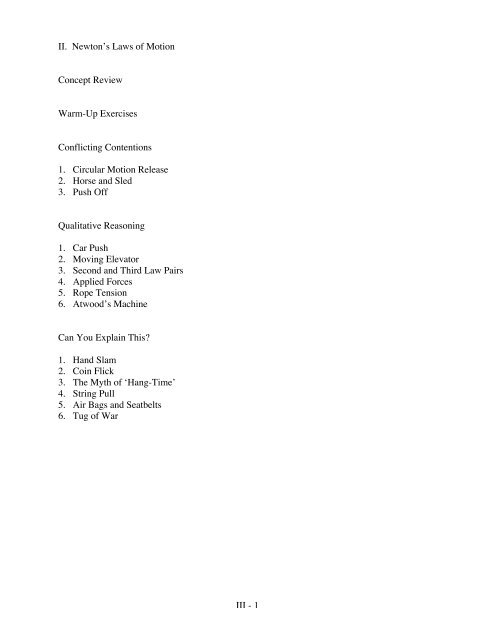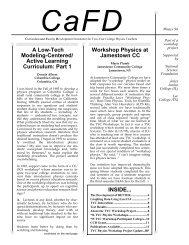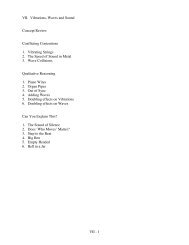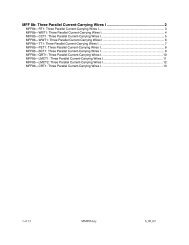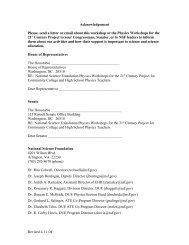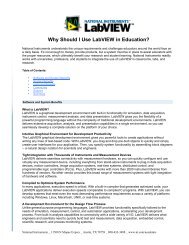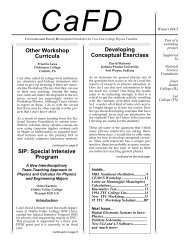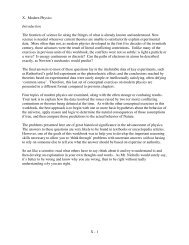III - 1 II. Newton's Laws of Motion Concept Review Warm-Up ...
III - 1 II. Newton's Laws of Motion Concept Review Warm-Up ...
III - 1 II. Newton's Laws of Motion Concept Review Warm-Up ...
You also want an ePaper? Increase the reach of your titles
YUMPU automatically turns print PDFs into web optimized ePapers that Google loves.
<strong>II</strong>. Newton’s <strong>Laws</strong> <strong>of</strong> <strong>Motion</strong><br />
<strong>Concept</strong> <strong>Review</strong><br />
<strong>Warm</strong>-<strong>Up</strong> Exercises<br />
Conflicting Contentions<br />
1. Circular <strong>Motion</strong> Release<br />
2. Horse and Sled<br />
3. Push Off<br />
Qualitative Reasoning<br />
1. Car Push<br />
2. Moving Elevator<br />
3. Second and Third Law Pairs<br />
4. Applied Forces<br />
5. Rope Tension<br />
6. Atwood’s Machine<br />
Can You Explain This<br />
1. Hand Slam<br />
2. Coin Flick<br />
3. The Myth <strong>of</strong> ‘Hang-Time’<br />
4. String Pull<br />
5. Air Bags and Seatbelts<br />
6. Tug <strong>of</strong> War<br />
<strong><strong>II</strong>I</strong> - 1
CONCEPT REVIEW<br />
Dynamics is the study <strong>of</strong> why things move. This particular set <strong>of</strong> exercises will only<br />
consider the basic concepts <strong>of</strong> motion embodied in Newton’s Three <strong>Laws</strong> <strong>of</strong> <strong>Motion</strong>. A later<br />
chapter will explore particular applications <strong>of</strong> force concepts. Understanding the following<br />
definitions and principles will be both helpful and necessary for successfully answering the<br />
exercises in this section. However, this concept review is not meant to replace the full<br />
explanation <strong>of</strong> a textbook or lecture. If any <strong>of</strong> these principles are unfamiliar or confusing,<br />
please consult with an instructor or textbook.<br />
1. Forces cause accelerations. The acceleration <strong>of</strong> an object is proportional to the ‘net' applied<br />
force acting on it. The net force is the vector sum <strong>of</strong> all the forces acting on the object.<br />
2. Constant velocity motion, also called uniform motion, is considered ‘natural' and does not<br />
need to be explained. (‘Rest' is the special case <strong>of</strong> zero magnitude velocity.) In other words,<br />
forces are not needed to explain velocities; constant velocity is not caused by a net force.<br />
Instead, for an object to move with constant velocity, the net force on the object must be<br />
zero. This is the essence <strong>of</strong> <strong>Newton's</strong> First Law <strong>of</strong> <strong>Motion</strong>.<br />
3. Mass is the property <strong>of</strong> matter that resists the action <strong>of</strong> a force. Another word used to<br />
describe this property <strong>of</strong> an object is inertia. The acceleration <strong>of</strong> an object is inversely<br />
proportional to the mass for a constant force and is proportional to the magnitude <strong>of</strong> the<br />
applied force. This is <strong>Newton's</strong> Second Law <strong>of</strong> <strong>Motion</strong>, and may be expressed by the<br />
equation<br />
F = ma<br />
where F is the net force, m is the mass <strong>of</strong> the object, and a is the acceleration <strong>of</strong> the object.<br />
The direction <strong>of</strong> the acceleration must be in the direction <strong>of</strong> the net force.<br />
4. Forces always come in pairs. The application <strong>of</strong> the force caused by one body on a second is<br />
equal in magnitude and opposite in direction to the force caused by the second body on the<br />
first. This is <strong>Newton's</strong> Third Law <strong>of</strong> <strong>Motion</strong>.<br />
5. Newton’s Second Law <strong>of</strong> <strong>Motion</strong> applies to all the forces acting on a single object.<br />
Newton’s Third Law <strong>of</strong> <strong>Motion</strong> applies to the interacting forces between two objects.<br />
6. Forces exist independently <strong>of</strong> the accelerations that they cause; in other words, force is not<br />
defined as the product <strong>of</strong> mass and acceleration. Forces can be acting in situations where<br />
there are no accelerations, but if an object is accelerating, then there must be at least one<br />
external force acting on it.<br />
WARM-UP EXERCISES<br />
1. Why is it harder to push a shopping cart when it is full <strong>of</strong> groceries compared to when it is<br />
empty<br />
<strong><strong>II</strong>I</strong> - 2
2. A 3 kg mass is accelerated by a 6 Newton force. Both the mass and force are increased by 3<br />
units (i.e., a 6 kg mass experiences a force <strong>of</strong> 9 Newtons). The experiment is repeated and<br />
the acceleration <strong>of</strong> the mass is calculated.<br />
a. Is the calculated acceleration in the second case different from the first case If it is<br />
different, is the new acceleration larger or smaller than the previous one<br />
b. If the accelerations are different, explain why increasing both the mass and force by the<br />
same amount did not result in the same acceleration. If the accelerations are the same,<br />
use equations to show why they must be the same.<br />
c. If the accelerations are different, explain how one should increase both the mass and<br />
force so that the new acceleration would be the same as the original one.<br />
3. If you push against an immoveable brick wall, is the wall pushing back on you with the same<br />
force When a wrecking ball pushes against the same brick wall and knocks it over, is the<br />
brick wall pushing back with the same force on the wrecking ball while it is in contact with<br />
the ball and falling down (Assume the wall is pushed over as a single piece).<br />
4. Suppose you stop a metal ball rolling toward you with your foot.<br />
How much force would be required to stop the ball in the same length <strong>of</strong> time compared to this<br />
first case if it is moving twice as fast<br />
How much force would be required to stop the ball in the same length <strong>of</strong> time compared to the<br />
first case if it had twice the original mass<br />
How much force would be required to stop the ball in the same length <strong>of</strong> time compared to the<br />
first case if it had twice the original mass but was moving only half as fast<br />
All <strong>of</strong> these questions specified that the stopping time was going to be the same as the first case.<br />
Does that really make a difference In other words, would a different stopping time change any<br />
<strong>of</strong> your answers to these questions<br />
CONFLICTING CONTENTIONS<br />
1. Circular <strong>Motion</strong> Release<br />
The Situation<br />
Mr. Nicholls has another demonstration for the class. He has placed a hula hoop on the flat table<br />
top and set a marble against the inside edge. With a simple spinning motion, he gets the marble<br />
traveling at a constant speed around the inner edge <strong>of</strong> the hoop.<br />
<strong><strong>II</strong>I</strong> - 3
He then says the class, “In a moment I am going to lift the hoop <strong>of</strong>f the table and we are going to<br />
observe the motion <strong>of</strong> the marble afterward. But before I do that, I want to consider the<br />
possibilities <strong>of</strong> what might happen to the motion <strong>of</strong> the marble when I suddenly lift the hoop <strong>of</strong>f<br />
the table. I will show you a diagram <strong>of</strong> four possible paths the marble might take when I lift the<br />
hoop. I want you to write down a reasonable argument to support each case.<br />
“Of course, only one <strong>of</strong> the answers will be correct, so not only will you have to give me a<br />
possible explanation for each case, you will also have to be able to tell me afterward what is the<br />
mistake in reasoning for each <strong>of</strong> the wrong explanations after we see what actually does happen.”<br />
Will you accept Mr. Nicholls challenge Can you give a reason for each prediction<br />
4<br />
3<br />
2<br />
1<br />
The Predictions<br />
Here is the list <strong>of</strong> possibilities developed by the class (see the diagram):<br />
For Path 1:<br />
Path 2:<br />
A force supplied by the hoop is pushing the marble around its edge. When the<br />
hoop is lifted, that force is gone, so the marble could move opposite to the<br />
direction <strong>of</strong> the push, which is directly away from the center <strong>of</strong> the circle.<br />
(Everyone agrees that this possibility is very unlikely, since no one has ever seen<br />
an object released from a circular path behave that way.)<br />
It is true that the hoop is pushing on the marble, but it also has a velocity. So<br />
when the hoop is lifted, the marble should move away from the center <strong>of</strong> the<br />
circle but in a wide gentle arc until it finally travels in a straight line.<br />
Besides, that is the type <strong>of</strong> observation you would make if you were flinging a<br />
ball on a string in a circle over your head and suddenly let go <strong>of</strong> the string.<br />
Path 3:<br />
When the hoop is lifted, the marble moves in a straight line and tangent to the<br />
release point. That is what Newton’s First Law predicts.<br />
Path 4:<br />
Path 3 doesn’t take into account the forces acting on the ball after release.<br />
Although the push inward is gone, there is still a sideways push that kept it<br />
moving along the path, so the ball should travel in an arc but past the tangent line<br />
instead <strong>of</strong> before it, as with path 2. That path would also coincide with the arc<br />
that you would see if you let go <strong>of</strong> the ball on a string.<br />
<strong><strong>II</strong>I</strong> - 4
Which prediction do you believe is the correct one Or do you have a different prediction or<br />
reason<br />
The Answer<br />
Satisfied with their predictions and reasons, the class watches as Mr. Nicholls<br />
starts the motion and lifts the hoop. The ball travels in a straight line path, tangent to the circle at<br />
the last point <strong>of</strong> contact, which is Path 3.<br />
Now, can you explain what is wrong with the reasoning behind each <strong>of</strong> the other predictions<br />
Also, can you explain why the ball on the string appears from the point <strong>of</strong> view <strong>of</strong> the spinner to<br />
be traveling in an arc, when it fact it is traveling in a straight line<br />
2. The Horse and Sled<br />
This is a very old physics brain-teaser. See if you can figure out where and how the reasoning<br />
made in the question becomes illogical.<br />
A horse is pulling a wooden sled across the ground. According to Newton’s third law <strong>of</strong> motion,<br />
the force <strong>of</strong> the horse acting on the sled pulling it forward must be equal and opposite to the<br />
force <strong>of</strong> the sled pulling backward on the horse.<br />
According to Newton’s second law <strong>of</strong> motion, only net forces cause accelerations. Since the two<br />
forces must add to zero by the third law, the acceleration <strong>of</strong> the horse and sled must also be zero.<br />
So how can the sled ever move, much less accelerate<br />
Can you explain this<br />
Hint: The brain-teaser refers to both the second and third laws <strong>of</strong> motion, and the statements<br />
made about the two laws <strong>of</strong> motion are perfectly correct. But under what conditions do each <strong>of</strong><br />
the laws apply<br />
Follow-up question: It is true that an acceleration must be caused by a net force acting on an<br />
object. Can you identify the force or forces causing the acceleration <strong>of</strong> the horse and sled<br />
Hint: Under what conditions could the horse not cause the sled to move<br />
<strong><strong>II</strong>I</strong> - 5
3. Push Off<br />
The Situation<br />
Mr. Nicholls has asked for two volunteers from the class to help with a demonstration.<br />
He has Frank and Beth sit opposite each other on two chairs with wheels. Beth takes <strong>of</strong>f her<br />
shoes and puts her feet against Frank’s knees. Beth pushes <strong>of</strong>f, and the two chairs move in<br />
opposite directions. Beth is quite a bit smaller than Frank, so her chair moves noticeably faster<br />
than his.<br />
“Which student, Frank or Beth, experiences the greater force”, Mr. Nicholls asked.<br />
Do you have an answer to Mr. Nicholls’ question<br />
The Predictions<br />
Here were the class’s responses.<br />
Mary:<br />
Cathy:<br />
Daniel:<br />
“Beth did the pushing and Frank was just sitting there, so Beth must have been<br />
pushing harder that Frank because she was causing the acceleration.”<br />
“I agree with Mary. Besides, she was moving faster than Frank. Her acceleration<br />
was larger, so she must have experienced the greater force.”<br />
“I disagree. Frank didn’t accelerate as much as Beth because he has a greater<br />
mass. A greater mass requires a greater force, so Frank must have experienced a<br />
greater force than Beth.”<br />
Which student do you agree with Or do you have a different answer or explanation<br />
The Answer<br />
“Wait a minute,” says John, “I think this is one <strong>of</strong> Nicholls’ trick questions. The first law says<br />
forces cause accelerations, which we saw for ourselves. And the second law says force, mass<br />
and acceleration are all related, which is what we have been talking about. But what about the<br />
third law”<br />
“John is right,” says Mr. Nicholls. “All <strong>of</strong> your arguments make a lot <strong>of</strong> sense, but in fact the<br />
two forces are equal in magnitude and opposite in direction because <strong>of</strong> Newton’s Third Law <strong>of</strong><br />
<strong>Motion</strong>.”<br />
So then what is wrong with each <strong>of</strong> the explanations given by Mary, Cathy, and Daniel How<br />
can we reconcile their observations with Newton’s Third Law <strong>of</strong> <strong>Motion</strong>”<br />
<strong><strong>II</strong>I</strong> - 6
QUALITATIVE REASONING<br />
General Hint: For both the Qualitative Reasoning questions and Can You Explain This<br />
exercises, first consider which <strong>of</strong> Newton’s three laws should be applied to explain each<br />
particular situation before determining the correct answer to the problem.<br />
1. Car Push<br />
A truck has broken down on the side <strong>of</strong> the road and the owner <strong>of</strong> a small compact car is willing<br />
to help out. He nudges up to the truck’s bumper and begins pushing the truck down the highway.<br />
How does the force <strong>of</strong> the car acting on the truck compare to the force <strong>of</strong> the truck acting on the<br />
car:<br />
a. When the car and the truck are accelerating<br />
b. When the car and the truck are traveling at a constant velocity<br />
2. Moving Elevator<br />
Consider an elevator first accelerating upward from rest, then traveling at a constant velocity,<br />
and finally slowing down to a stop at one <strong>of</strong> the upper floors <strong>of</strong> a building. There are two forces<br />
acting on the elevator: the weight <strong>of</strong> the elevator and the tension in the cable attached to it.<br />
How do the magnitudes <strong>of</strong> these two forces compare:<br />
a. When the elevator is accelerating upward,<br />
b. When the elevator is moving at a constant velocity,<br />
c. And when the elevator is slowing down to a stop<br />
Now suppose the elevator makes the return trip to where it started from. How would the tension<br />
and weight magnitudes compare for each leg <strong>of</strong> the journey downward<br />
3. Second and Third Law Pairs<br />
A book is resting on a table. There are two forces acting on the book: the weight <strong>of</strong> the book<br />
pointing downward, and a ‘normal force’ caused by the table top, pointing upward.<br />
These two forces are equal in magnitude and opposite in direction, but this is not an example <strong>of</strong><br />
Newton’s Third Law <strong>of</strong> <strong>Motion</strong>. These forces are equal and opposite because the book is not<br />
accelerating: it is at rest. This is an application <strong>of</strong> Newton’s Second Law <strong>of</strong> <strong>Motion</strong>!<br />
a. What is the correct ‘third law pair’ reaction force for the normal force pushing up on the<br />
book<br />
<strong><strong>II</strong>I</strong> - 7
. What is the correct ‘third law pair’ reaction force for the weight <strong>of</strong> the book<br />
c. How could you demonstrate that the normal force and the weight cannot be a third law pair<br />
HINT: To identify the pair <strong>of</strong> forces resulting form Newton’s third law complete the sentence:<br />
“The force <strong>of</strong> A acting on B is equal and opposite to the force <strong>of</strong> B acting on A.”<br />
But replace ‘A’ and ‘B’ with two different words.<br />
For example, if I stretch a rubber band between my two fingers,<br />
“The force <strong>of</strong> the rubber band acting on my finger is equal and opposite to the force <strong>of</strong> my finger<br />
acting on the rubber band.”<br />
What two nouns do you need for each case in this problem<br />
4. Applied Forces<br />
A constant net force <strong>of</strong> 2 Newtons pushes a bowling ball from rest until it reaches a final speed<br />
<strong>of</strong> 2 m/s after 10 seconds.<br />
a. How much more time would it take with the constant force acting to increase the speed <strong>of</strong> the<br />
ball from 2 m/s to 4 m/s<br />
b. How much more time would it take with the constant force acting to increase the speed <strong>of</strong> the<br />
ball from 4 m/s to 8 m/s<br />
c. How much time would it take to reach the final speed <strong>of</strong> 2 m/s, compared to the first case, if<br />
the applied force was only 1 Newton<br />
d. How much time would it take to increase the speed <strong>of</strong> the ball by a total <strong>of</strong> 2 m/s, compared<br />
to the first case, if the ball did not start from rest but had an initial speed <strong>of</strong> 1 m/s (in other<br />
words, achieving a final speed <strong>of</strong> 3 m/s)<br />
5. Rope Tension<br />
This is another classic concept question, but very difficult to answer correctly. Two 10 Newton<br />
masses are hanging from two pulleys with a force spring scale between them, as shown in the<br />
picture.<br />
<br />
10 10<br />
<strong><strong>II</strong>I</strong> - 8
Would the spring scale read 0, 10, or 20 Newtons, or something else<br />
Suppose one side had a mass <strong>of</strong> 5 Newtons and the other side had a mass <strong>of</strong> 15 Newtons, so that<br />
the system was accelerating. Now what would be the scale reading (if you could read it while it<br />
accelerated past you)<br />
6. Atwood’s Machine<br />
Like Galileo, Atwood invented a ‘gravity dilution device’, as shown in the picture. Atwood’s<br />
machine consists <strong>of</strong> two masses attached to each other on opposite sides <strong>of</strong> a pulley. The two<br />
masses are able to remain at rest if the two masses are equal (m1 = m2); if the two masses are not<br />
equal, then they will experience an acceleration, with the heavier mass falling and the lighter<br />
mass rising.<br />
m 2<br />
m 1<br />
Suppose we construct an Atwood’s machine by placing 5 masses with a weight <strong>of</strong> 0.1 Newton<br />
each on two identical 0.5 Newton weight hangers, resulting in a total weight <strong>of</strong> 1.0 Newton on<br />
each side <strong>of</strong> pulley.<br />
a. Suppose you tap one <strong>of</strong> the weight hangers under these conditions <strong>of</strong> equal weight, pushing it<br />
downward. What would you observe about the motion <strong>of</strong> the two masses<br />
One 0.1 Newton weight is now transferred from one weight hanger to the other, causing one side<br />
to have a weight <strong>of</strong> 1.1 N and the other to have a weight <strong>of</strong> 0.9 N. When the weight hangers are<br />
let go, the two masses accelerate due to the force difference <strong>of</strong> 0.2 N.<br />
b. If a second 0.1 N weight is transferred from the lighter side to the heavier side, how will the<br />
acceleration <strong>of</strong> the weight hangers compare to the previous situation<br />
Now suppose a force difference <strong>of</strong> 0.2 N is maintained, but an extra 0.5 N <strong>of</strong> weight is added to<br />
both <strong>of</strong> the weight hangers.<br />
c. How will the acceleration <strong>of</strong> the system change compared to the previous case, or will it stay<br />
the same as before<br />
<strong><strong>II</strong>I</strong> - 9
CAN YOU EXPLAIN THIS<br />
1. Hand Slam<br />
Why does it hurt more if you slam the back <strong>of</strong> your hand against the wall when you are holding a<br />
book compared to when your hand is empty Which <strong>of</strong> Newton’s laws is most useful for<br />
explaining this observation<br />
2. Coin Flick<br />
Try this yourself. Set a 3x5 index card on top <strong>of</strong> a glass and place a coin on top <strong>of</strong> the card over<br />
the center <strong>of</strong> the glass. Flick the edge <strong>of</strong> the card quickly with your index finger and the coin<br />
falls into the glass. Can you explain the motions <strong>of</strong> both the coin and the card using Newton’s<br />
laws <strong>of</strong> motion<br />
3. The Myth <strong>of</strong> ‘Hang-Time’<br />
Use Newton’s laws to explain why it is impossible for a basketball player to have a ‘hang time’<br />
when jumping into the air to make a shot.<br />
4. String Pull<br />
You can try this yourself if you can find an object with a mass around 1 kilogram that has two<br />
hooks or holes on opposite sides, so that you can tie two strings to it. If you do try this, it is<br />
important that the string is made <strong>of</strong> cotton: you will never be able to break a nylon string!<br />
Tie a string to each side <strong>of</strong> the heavy object. Hold the object in the air with one string.<br />
<strong><strong>II</strong>I</strong> - 10
Pull the lower string quickly and the lower string breaks.<br />
Pull the lower string slowly and the upper string breaks.<br />
Warning: If you try this yourself, make sure the mass is not too heavy and move your hand out <strong>of</strong><br />
the way so it doesn’t get hit by the falling mass!<br />
Can you explain these results using Newton’s laws <strong>of</strong> motion<br />
Which <strong>of</strong> Newton’s law(s) are most useful for explaining the observations made in each<br />
situation<br />
5. Air Bags and Seat Belts<br />
Use Newton’s laws <strong>of</strong> motion to explain how an air bag is able to save a person’s life in a headon<br />
car crash.<br />
Why is an air bag dangerous to a small person, young child, or infant<br />
Use Newton’s laws <strong>of</strong> motion to explain how seat belts are able to save a person’s life in a car<br />
crash.<br />
Why are seat belts a useful safety device no matter what the direction <strong>of</strong> impact, but air bags are<br />
most effective in head-on collisions<br />
6. Tug <strong>of</strong> War<br />
The physics class is having an imaginary tug <strong>of</strong> war — the men against the women. For a long<br />
time the two teams are pulling with equal force and the knot in the center <strong>of</strong> the rope isn’t going<br />
anywhere. But then Frank sneezes and stops pulling as hard for just a few seconds. Of course,<br />
he quickly recovers, and the two sides are pulling with equal strength once again.<br />
“Is it possible”, Mr. Nicholls asks, “to determine who wins the tug <strong>of</strong> war based on this<br />
information”<br />
“Of course not,” Frank says, “The other team was pulling with greater force for a short time, but<br />
the two forces are equal again. So the knot in the middle moved a little bit towards the girls’ side<br />
but then stopped. The tug <strong>of</strong> war isn’t over yet.”<br />
“Wait a minute,” Cathy says, “You have to listen carefully to the set-up. Mr Nicholls said that<br />
the girls were pulling harder for a short time, but then the boys recovered and began pulling with<br />
the same force as they were before. That means that our side won! Right Mr. Nicholls”<br />
Cathy is right: the women do win the tug <strong>of</strong> war. But can you apply Newton’s laws correctly to<br />
explain why that is the case<br />
<strong><strong>II</strong>I</strong> - 11


